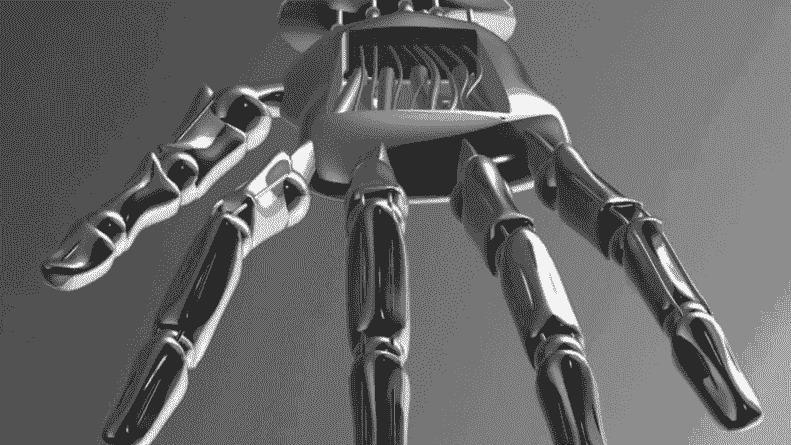
This tiny robot can melt, escape a prison by squeezing through tight bars, and then solidify and carry out its duties.
In Terminator 2: Judgment Day, the purpose of the first terminator, portrayed by Arnold Schwarzenegger, is to safeguard Sarah and John Connor from the T-1000, a futuristic killer robot so ductile that it can easily regain its shape after being hit or shot.
Liquid Metal Robot
Now, Chinese and American scientists have developed something resembling a miniature T-1000. The creation, consisting of a metal that melts at temperatures close to ambient temperature, may transform from solid to liquid at the makers’ discretion.
During the testing, the robot was able to escape from a cage by melting through the bars and reforming on the other side. It is capable of removing a foreign object from the stomach and soldering an LED circuit.
The T-1000 in the James Cameron film was a liquid metal mimetic polyalloy prototype produced by the nefarious corporation Skynet.
The new robot, which was reported this week in the scientific journal Matter, is likewise comprised of a metal matrix: gallium, which melts at 85.6oF (29.4oC) when pure. In other words, it dissolves in the hand.
In addition to gallium, the robot has an alloy of three other elements (neodymium, iron, and boron) to enhance its magnetic field reaction.
The robot is constructed from magnetoactive phase transitional matter or MPTM for short. At a particular intensity, a magnetic field creates an electric current within the gallium, producing heat and transforming it from solid to liquid.
Without hitting that threshold, these magnetic forces can also cause the robot to leap twenty times its height, rotate at a rate of 1,500 rotations per minute, and travel at a rate of one meter per second. It may not be as large as the T-1000 in the film it is barely a centimeter tall but it is a powerhouse.
In one of the videos provided by the researchers (see above), the MPTM robot in the form of a LEGO minifigure measuring approximately five millimeters wide and one centimeter tall can be seen escaping from a small cage by passing through the bars in a liquid state and then solidifying once it is free.
Read more: Take a look at the Minecraft Legends online vs mode, which is playable on multiple platforms
Technologists Elaborate On Process

Professor of mechanical engineering at Carnegie Mellon University Carmel Majidi explains that a magnetic field is utilized to melt it to a liquid and remove it from the container.
In the same way, as gallium melts near 86oF (30oC), it solidifies below that temperature, and once it has passed through the bars, it reverts to a hard metal. The fact that it melts in your palm does not exclude it from having the same hardness as other metals.
The scientists devised numerous tests to evaluate their invention. In one, they transform it into a screw capable of reaching corners, which enters a hole in liquid form and then solidifies to seal it.
In another, the MPTM robot operates as a welder on an LED circuit, utilizing a portion of itself as solder; gallium functions as both a solder and a conductive material, and like other metals, it has a high electrical conductivity, making it particularly effective for joining circuits. However, if it’s molten at room temperature, what will happen when the circuit heats up?
Majidi recognizes the issue of its state change. When the circuit is heated, gallium has the ability to soften and even melt due to its low melting point. Therefore, its performance is unaffected by its liquid state.
However, it would need to be sealed with rubber or another soft insulating material to prevent leaking or spilling, he notes.
As the director of the Soft Machines Lab at Carnegie Mellon, Majidi’s area of expertise is soft materials, ranging from crystals to liquid metals, and he is not overly concerned about his MPTM melting: The majority of my research focuses on liquid metal circuits in which the conductive material remains liquid during circuit operation.
As long as the metal is adequately sealed and insulated, leaks are generally of little concern, he explains.
The creators of the MPTM believe it may have significant medical applications. Using a human stomach model filled with water, they handled two extremely typical medical problems: first, they guided a robot to an object that needed to be removed.
Once adjacent, a magnet burned the robot, which then encircled the target. Then, once it had cooled, it was quickly retrieved using magnets. In the other, the administration of a medication wrapped in MPTM was evaluated. Once it arrived at its destination, it melted and discharged the medicine.
An engineer from the Chinese University of Hong Kong and co-author of the paper, Chengfeng Pan, noted that providing robots the capacity to flip between liquid and solid states gives them more capability. According to him, the next step is to promote this system of materials in order to address certain very particular medical and engineering challenges.
Read more: First AI Robot attorney will represent a defendant in court next month!

